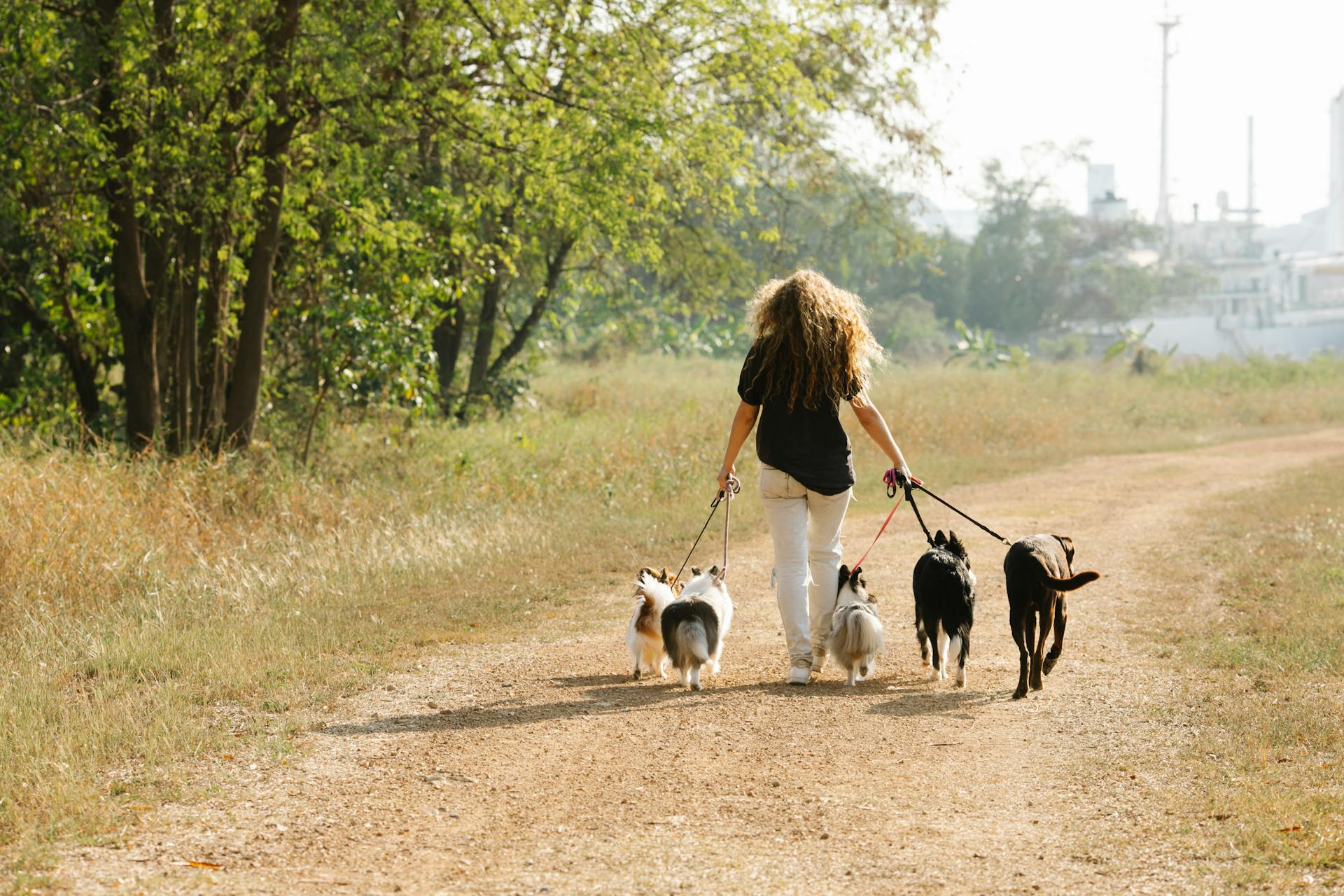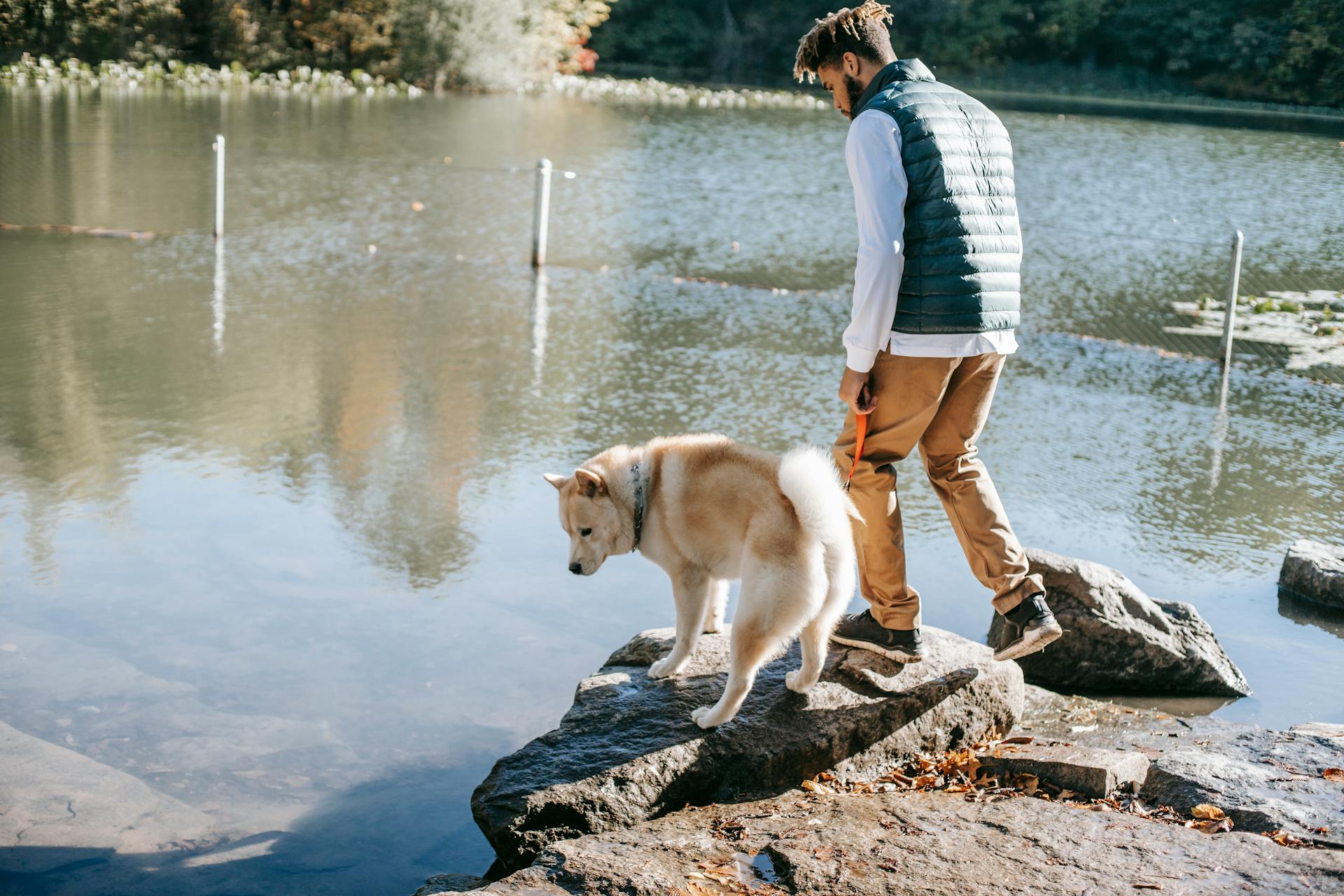
Disciplining your dog for stealing food can be a challenge, but it's not impossible. According to research, dogs steal food because they are driven by instinct and a desire for rewards.
One of the main reasons dogs steal food is because they are opportunistic eaters. They will take advantage of any situation where they can get a free meal.
To prevent problems, it's essential to establish clear boundaries and rules. For example, you can designate specific areas where your dog is allowed to eat, such as their own food bowl.
By setting these boundaries, you can help your dog understand what is and isn't acceptable behavior.
Understanding Dog Behavior
Resource guarding is a common issue in dogs, where they become possessive of their food or toys. This behavior can be triggered by a variety of factors, including a dog's distance threshold, which is the point at which they begin to feel threatened by your presence.
Dogs with a low distance threshold may become tense or aggressive when you approach them, even if it's just to give them a treat. To address this behavior, it's essential to find your dog's distance threshold and work with them at that point.
Desensitization and counterconditioning training can help your dog become more comfortable with your presence near their food or toys. This training involves gradually increasing your proximity to your dog while offering treats, starting from a safe distance.
Here are the steps to find your dog's distance threshold:
- Find a high-value treat that your dog loves more than the thing they are guarding.
- Know the distance at which your dog begins to resource guard.
- Give your dog their meal or chew as usual, then walk away.
- Approach your dog, but stop a short distance beyond their distance threshold.
- Toss a piece of chicken to them, then turn and leave.
- Continue this exercise any time your dog has something they guard.
By understanding your dog's behavior and working with them gradually, you can help them become more comfortable with your presence near their food or toys.
Signs of Dogs Stealing Food
Dogs stealing food is a common behavior in many households. They often do this because they've learned that it's a quick and easy way to get a snack.
Dogs are naturally scavengers and will eat just about anything they can get their paws on. They've been known to steal food from the counter, the table, and even the trash.
A dog's sense of smell is incredibly strong, and they can detect food from far away. This is why they often get into trouble when food is left unattended.
Dogs will often use their cuteness and charm to get what they want, including food. They'll sit, stay, and even give you the puppy dog eyes to get you to give in.
Some dogs are more prone to stealing food than others, especially those with a history of being fed table scraps.
Comparing Dogs to Other Animals
Dogs will guard resources from each other, or even other pets in the home, like cats, which is called dog-directed resource guarding.
Resource guarding behaviors can happen over a certain resting place, food bowls, or high-value chews and toys, especially when resources are limited.
In multi-dog households, you might see the ebb and flow of resource guarding "conversations" they have, which is called ritualized aggression.
True aggression is an expensive behavior for dogs to engage in, risking injury or worse, and most dogs want to avoid it if possible.
For more insights, see: How to Help a Dog with Food Aggression
Dogs may posture and act "tough" but not back it up with true aggressive engagement with the other dog when push comes to shove, which is a normal part of dog communication.
However, ritualized aggression can indicate underlying stress and negative emotional associations.
My dog Sookie is possessive of chews in the office, but she is conflict-averse and gives low-level signals to the other dog, which means, "This chew is mine. Leave me alone."
Causes of Dog Food Stealing
Dogs can develop food aggression due to various reasons, including learning it in puppyhood through accidental training practices or competing for limited resources in a shelter environment.
Dogs that have experienced trauma, such as losing a caretaker or physical abuse, are more likely to become protective of their food.
Some breeds are genetically predisposed to dominant or aggressive tendencies, leading them to guard food due to a pack-like mentality.
Dogs that have spent time in a shelter may be at a higher risk of experiencing food aggression due to competition for available resources like food.
What Is Dog Food Stealing?
Dog food stealing is a common issue many pet owners face. It's estimated that up to 25% of dogs will steal food at some point in their lives.
Dogs can develop a strong association between food and attention, leading them to steal food as a way to get attention from their owners.
Some breeds, such as Beagles and Basset Hounds, are more prone to food stealing due to their strong hunting instincts.
Dogs may also steal food due to boredom or lack of mental stimulation, leading them to seek out other sources of excitement.
In one study, 71% of dogs who stole food did so due to attention-seeking behavior.
Intriguing read: Dogs Stealing Food
Disease Causes in Dogs
Some dogs steal food due to underlying medical conditions, such as gastrointestinal issues.
Dogs with gastrointestinal problems often experience nausea and vomiting, leading them to seek out food.
Food theft can be a sign of pancreatitis, a painful and potentially life-threatening condition.
Pancreatitis can cause a dog's pancreas to become inflamed, leading to a range of symptoms including vomiting and diarrhea.
In some cases, food theft can be a symptom of diabetes, which affects a dog's ability to regulate blood sugar levels.
Dogs with diabetes may experience increased hunger and thirst, leading them to seek out food.
Hypothyroidism, a condition where the thyroid gland doesn't produce enough hormones, can also contribute to food theft in dogs.
Dogs with hypothyroidism may experience weight gain, skin problems, and a decrease in their overall energy levels.
Expand your knowledge: What Food Causes Diabetes in Dogs
Dog Guarding Behavior
Dog guarding behavior is a common issue that can be challenging to address. It's essential to understand the signs of resource guarding in dogs, which can range from subtle to intense.
Growling, lunging, and biting are obvious signs of resource guarding, but dogs may also display more subtle behaviors like freezing, eating faster, or taking an item and moving away. If you notice any of these signs, it's crucial to address the issue promptly.
In multi-dog households, resource guarding can become a problem if dogs resort to fighting over resources. However, most dogs will gauge whether a particular resource is worth fighting for, and many will communicate with each other using body language and vocalizations to express their desire for the resource.
If you have a dog that guards resources, it's essential to teach them that your removing an item, such as their chew, results in something equal to or better than what they had. This can be achieved through desensitization and counterconditioning training, which takes time and repetition.
Here are some common signs of resource guarding in dogs:
- Growling
- Lunging and air snapping
- Chasing you or another animal away
- Biting
- Freezing
- Eating faster
- Taking an item and moving away
- Braced body position over the item
- Subtle shifting of body weight to "block" the item
- Side eye staring or tracking of the person or pet approaching
- Raising lips and baring teeth
- Ears pinned flat against the head
- Hard stare
To address resource guarding, it's best to work with a certified dog trainer or behavior consultant. They can help you develop a training plan that includes exercises like finding a high-value treat that your dog loves, determining their distance threshold, and gradually decreasing their distance threshold.
Remember, desensitization and counterconditioning training for resource guarding takes time and repetition. Be patient and consistent, and work with your dog to help them feel more comfortable with you approaching their resources.
Training a Dog
Training a dog to stop stealing food requires patience, consistency, and positive reinforcement. It's essential to connect with a certified dog trainer or behavior consultant before starting any exercises, especially if your dog has a history of resource guarding.
To begin, find a high-value treat that your dog loves more than the thing they are guarding. Moist and smelly treats like small pieces of chicken or turkey hotdog usually work best.
Desensitization and counterconditioning training for resource guarding takes time and repetition, so don't rush through the process. Start by finding your dog's distance threshold, which is the point at which they begin to resource guard.
Here are the steps to find your dog's distance threshold:
- Give your dog their meal or chew as usual, then walk away.
- Approach your dog, but stop a short distance beyond their distance threshold.
- Toss a piece of chicken to them, then another, and repeat this process a few times before turning and leaving.
Continue this exercise any time your dog has something they guard, and gradually decrease their distance threshold by adding one more step towards them before tossing the treat.
Preventing Problems
Preventing problems is key to avoiding unwanted behavior like stealing food. Supervise your puppy at all times when it's not confined to prevent mischief and damage.
Keeping your puppy engaged in desirable behaviors like chewing on toys or participating in training exercises can prevent undesirable behaviors from arising. This can include feeding toys and stuffed toys to keep them occupied.
A remote leash attached to your puppy can prevent or interrupt inappropriate behaviors like garbage raiding, chewing on household items, or house-soiling when you're not around. Confinement is necessary if your puppy can't be supervised.
Leaving a remote leash attached to a head halter can also help correct problems like nipping, play biting, and jumping up.
Here's an interesting read: Leash Training Your Dog
Recognizing Aggression
Food aggression is a common issue in dogs, and it's essential to recognize the signs early on. According to Example 5, nearly 20 percent of all dogs show signs of food aggression.
A dog displaying food aggression may stiffen its body and lower its head, displaying body language to "hover" around its meal and protect it (Example 2). This behavior can be a sign of resource guarding, a behavior passed down through evolution when dogs needed to protect every meal or resource they had.
The severity of food aggression can vary, ranging from mild to severe. In a mild case, the dog may growl and bare its teeth when approached (Example 6). A moderate case involves the dog snapping or lunging when a person or other dog approaches (Example 6). Severe food aggression can be dangerous, with the dog biting or chasing perceived threats away (Example 6).
If you suspect your dog is displaying food aggression, it's crucial to assess the situation and consider the overall behavior of your dog. If the behavior extends beyond food to other resources, such as toys or people, it may be a sign of general resource guarding (Example 3).
Here are the three degrees of food aggression to watch out for:
Preventing and Solving Problems
Preventing resource guarding in puppies is much easier than treating it, so it's essential to set your puppy up for success from the start. This means setting up proactive training exercises, such as those outlined in my article How to Prevent Resource Guarding.
Supervising your puppy at all times is crucial to prevent mischief and damage. This means keeping an eye on your puppy even when it's not confined.
Keeping your puppy engaged in desirable behaviors like chew toys, feeding toys, and training exercises can prevent undesirable behaviors like garbage raiding and chewing on household items.
Leaving a remote leash attached can prevent or interrupt inappropriate behavior like wandering off into rooms or areas that are out of bounds.
Sources
- https://www.preventivevet.com/dogs/resource-guarding-in-dogs
- https://roguepetscience.com/blogs/dog-training/food-aggression-in-dogs
- https://rawbistro.com/blogs/raw-bistro/food-aggression-in-dogs
- https://vcahospitals.com/know-your-pet/puppy-behavior-and-training---dealing-with-undesirable-behavior
- https://petexpertise.com/blogs/news/dog-training-article-using-physical-punishments
Featured Images: pexels.com


